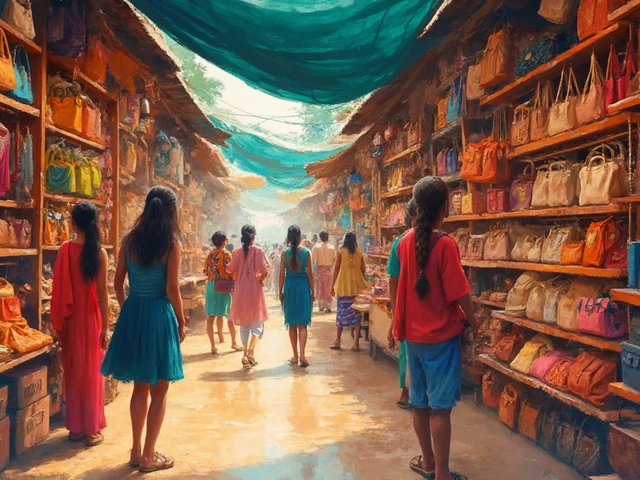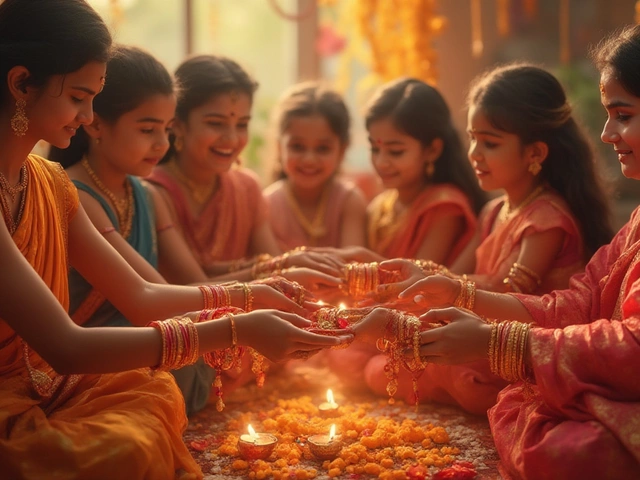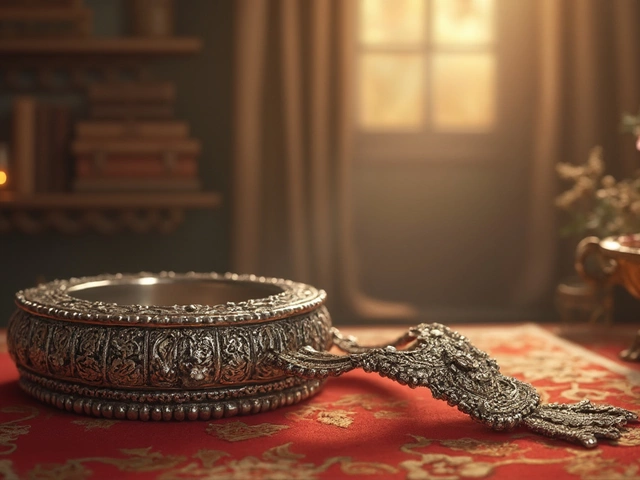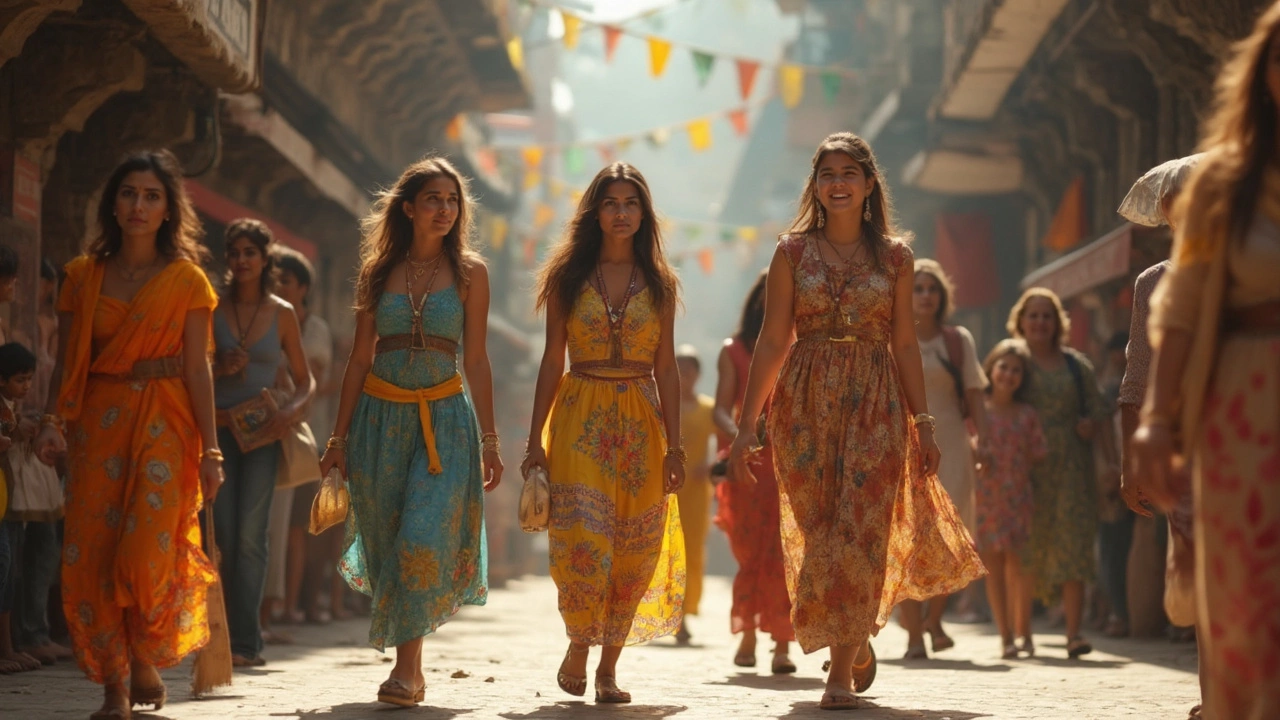
So you’re packing for India and staring at your favorite dress, unsure if it’ll make the cut. Good news: People do wear dresses in plenty of places across India, but the “is it OK?” part really depends on where you’re heading and what you’ll be doing.
Indian cities, especially metro areas like Mumbai and Bangalore, see everything from short summer dresses to long maxis on the street. In smaller towns or rural spots though, you’ll notice things get more conservative. The same dress that raises zero eyebrows in Goa could leave you feeling way too exposed in Lucknow. That’s not a judgment—it’s just how social vibes roll here.
Comfort matters with India’s weather, and dresses are actually a smart way to beat the heat. The key? Go for mid-length or maxi styles if you want no fuss anywhere you roam. Pay attention to how locals dress when you arrive—nothing answers your questions faster than people-watching your first couple of days.
- How Dresses Fit Into Indian Fashion
- Cultural Norms and Regional Differences
- What Types of Dresses Get a Thumbs Up
- Dresses for Hot Indian Weather
- Accessorizing Smartly
- Real Stories and Things to Avoid
How Dresses Fit Into Indian Fashion
Dresses aren’t some strange import in India. Sure, traditional outfits like salwar kameez, kurtis, lehengas, and sarees have ruled for generations, but western-style dresses have been in the mix for decades. Walk into any clothing store in a big city and you’ll find racks of casual or party dresses right next to traditional wear.
Fashion trends shift fast in India’s urban centers. You’ll spot college students in midi dresses, professionals pairing tailored dresses with simple jewelry, and celebs hitting Mumbai events in global fashion labels. Online shopping has made trendy western dresses in India super easy to find. Flipkart, Myntra, and Amazon each list thousands of dress styles—last year, dresses ranked as one of the top five women’s clothing searches in India.
Big events like weddings, festivals, or family gatherings usually call for Indian wear, but even here, things are changing. It’s pretty common at after-parties for younger folks to swap out heavy outfits for breezy western dresses. Malls, brunch spots, and office parties often follow this blend of styles.
| Event | Traditional | Western Dresses |
|---|---|---|
| Daily wear (metro cities) | Kurtis, salwar kameez | Everyday dresses, midis, t-shirt dresses |
| College / Office | Kurta, churidar | Sheath dresses, shirt dresses |
| Weddings | Saree, lehenga | Cocktail dresses (evening events) |
| Clubs, brunch, malls | Semi-ethnic | Party dresses, sundresses |
What really makes Indian fashion unique? People here love mixing it up—think denim jackets over kurti dresses or sneakers with flowy anarkalis. The key idea is comfort and looking current, not getting locked in by tradition. Young folks in India want outfits that let them stand out, but also blend in with what’s trending globally.
Cultural Norms and Regional Differences
If you’re wondering about wearing dresses in India, you’ve got to look at how different this huge country really is. A few hours’ drive can totally change what’s cool to wear. That’s why one rule doesn’t fit all.
In Goa or Pondicherry, it’s pretty common to see locals and tourists in sundresses, shorts, or even beachwear. Head north to Delhi or Jaipur, and you’ll still find lots of people into western wear, especially younger crowds. Metro cities like Bangalore, Mumbai, and Hyderabad are pretty used to Western styles, so *dresses in India* aren’t usually a big deal there.
But that changes if you’re off to smaller cities, holy sites, or rural towns. In places like Varanasi, Haridwar, or small towns in Rajasthan, people expect more covered-up clothing—think shoulders and knees covered. Local women often wear saris or salwar suits, and western dresses are pretty rare. If you walk down a conservative street in a strappy dress, you’ll probably feel most of the stares.
- Big cities = more relaxed, dress how you like (within reason)
- Small towns & rural areas = cover up more, stick to longer hemlines and sleeves
- Religious places = no bare shoulders or short skirts, ever
Check out this quick look at comfort levels in different Indian regions:
| Region/City | Common Attire | Dresses Acceptable? |
|---|---|---|
| Goa | Shorts, tees, sundresses | Yes |
| Mumbai | Western and Indian mix | Yes |
| Delhi | Jeans, western, traditional | Yes, watch the length |
| Jaipur (centre) | More traditional | Maxis, longer skirts best |
| Rural Rajasthan | Saris, traditional suits | No, unless long and modest |
| Varanasi | Traditional, religious | Long and very modest only |
So, use common sense and match your outfit to the location. If you want zero hassle, keep a light scarf (dupatta) handy for extra cover-up when needed. This way, you’ll blend in fast and stay comfortable, no matter where you end up.
What Types of Dresses Get a Thumbs Up
Let’s get real: not every dress style will fly everywhere in India. What you choose can totally change how comfortable you feel. If you’re looking for the safest bet, go for mid-length or maxi dresses. These offer good coverage and help you blend in better, especially if you’re not in a big city. Sleeveless is common in tourist hotspots, but most locals still stick to short sleeves or cap sleeves outside metro areas—so packing a lightweight scarf or shrug makes things easier if you feel out of place.
Comfort-wise, cotton and linen are your friends for most of the year. India’s humidity and heat can turn polyester into a sweat trap. As for prints? Florals and solids are everywhere, but wild, bold graphics sometimes get stares, especially in smaller towns. Bright colors are part of the culture, but skin-tight styles are less common outside nightlife or beach zones like Goa.
If you want to play it super safe or plan temple visits, wear something that covers knees and shoulders. Markets in Delhi or Jaipur have tons of local brands selling long cotton dresses designed just for the climate and comfort. Want numbers? Last year, a survey by a major Indian retail chain found that about 68% of urban Indian women include at least one midi or maxi dress in their wardrobe. But mini-dresses accounted for less than 15% of city purchases, and almost zero in small towns.
| Dress Type | Urban Popularity | Rural/Small Town Popularity | Where It Works Best |
|---|---|---|---|
| Maxi Dresses | High | Medium | Cities, tourist spots |
| Midi Dresses | Very High | Medium | Most places |
| Mini Dresses | Low-Medium | Very Low | Nightlife, parties, Goa |
| Sleeveless | Medium | Low | Cities, resorts |
| Full Sleeve | Medium | High | Temples, rural areas |
Here’s what tends to work anywhere except super conservative spots:
- Loose, breathable fabrics (cotton, linen)
- Dresses that hit at the knee or lower
- Simple prints or solid colors
- Covering your shoulders outside touristy zones
If you ever feel uncertain, copy what local college students wear. They’re practical, and their picks walk the line between tradition and global style. When in doubt, throw a scarf or light jacket in your bag—easy fix for sudden dress code changes!
And if you care about the dresses in India look? Long cotton dresses are selling out every summer—locals and tourists both love them because they feel right at home in the sticky heat and bustling crowds.
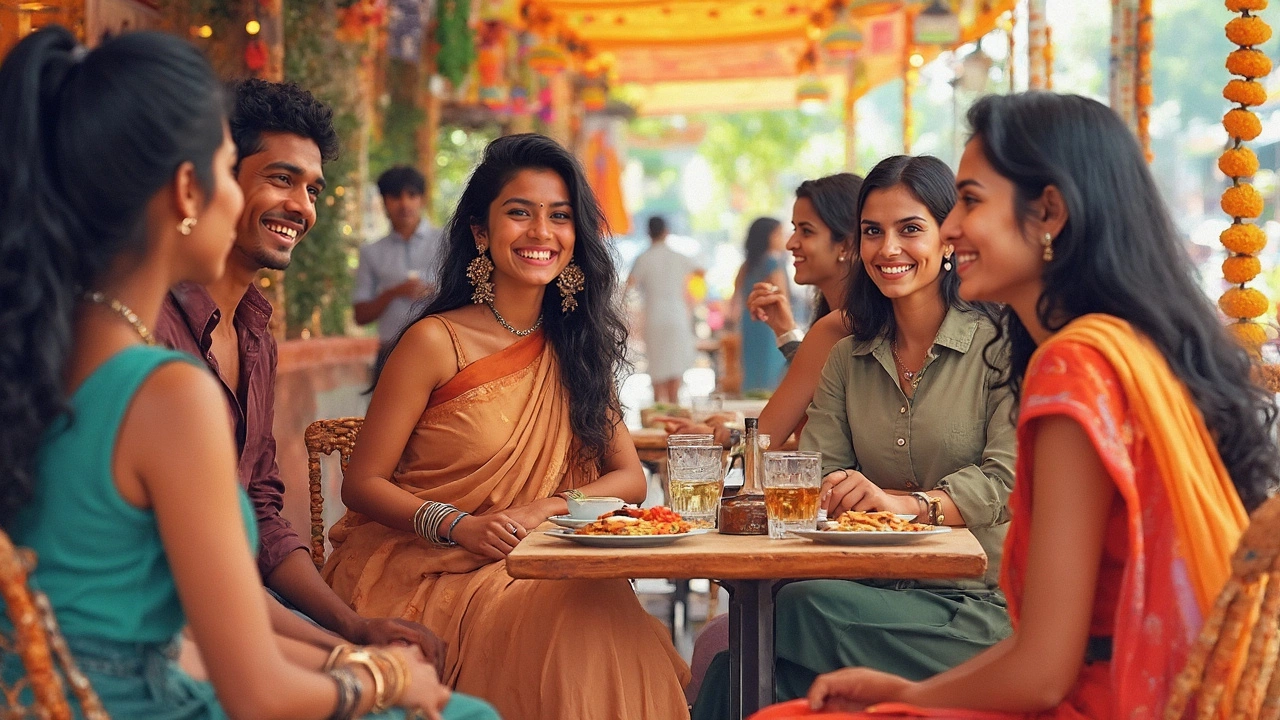
Dresses for Hot Indian Weather
High temperatures are part of daily life in most of India, especially between March and June, when the mercury can shoot past 40°C (104°F) in cities like Delhi or Hyderabad. Humidity is another major player, especially along the coasts. Choosing the right dress isn’t just about style—it’s about keeping cool and comfy, too.
Light, breathable fabrics make all the difference. If you want to avoid sweating buckets, stick to:
- Cotton: Super common in local markets, easy to wash, and dries fast.
- Linen: Even lighter than cotton but wrinkles more, so keep that in mind.
- Rayon: Cheaper, feels breezy, but can get clingy if you sweat a lot.
Avoid polyester and other synthetics unless you love feeling sticky. If you see locals wearing a certain style, there's usually a practical reason—midis and maxis help block the sun, and loose fits give air a place to flow.
Here’s a quick look at what you can expect, climate-wise, in a few key cities:
| City | Peak Summer Temp (°C) | Humidity (%) | Recommended Dress Style |
|---|---|---|---|
| Delhi | 42 | 35-45 | Loose cotton midi/maxi |
| Mumbai | 36 | 70-80 | Linen shift dress |
| Kolkata | 40 | 60-70 | A-line cotton dress |
| Bangalore | 34 | 50-60 | Rayon maxi dress |
One big tip: layers. Light scarves or stoles aren’t just a local accessory—they give you quick coverage when stepping into temples or dealing with sudden sun. You can easily pair them with your dresses in India to keep things cool but culturally comfortable.
Washing opportunities are everywhere, but colors fade fast in the strong sun. When in doubt, pack an extra dress or grab a couple from local shops. Street markets have tons of options designed just for this heat—and you’ll fit right in.
Accessorizing Smartly
If you’re wondering how to make your dress work while blending in—and standing out for the right reasons—accessorizing is your best friend. In India, people love adding personality through simple extras. A scarf (dupatta) goes a long way, both for style and for covering up quickly if you find yourself in a place where modesty matters more. Scarves are cheap, everywhere, and come in every color.
Light jewelry works, too. Indians wear bangles, earrings, and anklets without making a fuss. But keep it practical: skip anything flashy if you’re out sightseeing or taking public transport. Sneakers or simple sandals beat high heels for most outings. Always grab a tote or crossbody bag—crowded areas and pickpocketing can be an issue.
"A scarf or stole in your bag is the smartest accessory you’ll ever pack for India," says travel columnist Sonali Bendre in an interview for Vogue India. "It can save you from the sun, offer modesty in temples, and instantly dress up a simple outfit."
Want to know how locals accessorize during summer when it gets seriously hot? Here’s some quick data for major Indian cities:
| City | Average Summer Temp (°C) | Accessory of Choice |
|---|---|---|
| Delhi | 35-42 | Broad-brim hats, cotton dupattas |
| Mumbai | 30-37 | Light scarves, sunglasses, easy sandals |
| Bangalore | 27-34 | Light jackets, sun hats, small handbags |
For an extra hack, try styling your dresses in India with a belt—this helps keep your look neat even after hours in the heat. Women in big cities often pair western dresses with local touches, like chunky bangles or a simple bindi on the forehead. It’s easy, affordable, and you’ll notice how it helps you fit in while staying true to your style.
- Always carry a scarf or dupatta, especially if you plan temple visits or plan to be out all day.
- Go for crossbody bags in crowded places—they’re safer and leave your hands free.
- Choose jewelry you can leave on or stow in your bag last minute.
- Comfy sandals or sneakers will take you everywhere—leave the stilettos at home.
Blend western style with Indian smarts, and you’ll look good and feel comfortable whatever the day throws at you.
Real Stories and Things to Avoid
You’ve probably heard all sorts of mixed advice about wearing dresses in India. Here's what you actually need to know—straight from people who’ve done it and some facts that matter.
First, city dwellers—locals and travelers alike—often wear western clothing, including dresses. A tech-worker friend in Bangalore shared that her knee-length dresses never raised eyebrows at malls or coffee shops, but she’d layer with a scarf if hopping on public buses. Meanwhile, another person in Jaipur felt awkward walking through traditional neighborhoods in a sleeveless dress. She switched to a longer, light cotton dress with sleeves and felt instantly more comfortable.
Social media is full of photos from places like Goa and Pondicherry showing tourists in all kinds of summer dresses, but if you check traveler forums, you’ll see the same message over and over: city, beach, and touristy areas are much more accepting. Visit a small temple town wearing a bodycon mini-dress, though, and you’ll feel out of place fast.
It's not just about blending in—it’s also about avoiding unwanted attention. Women’s safety is a hot topic, with the 2023 National Crime Records Bureau reporting that 80% of harassment reports in public places involved catcalling or unwanted staring, often toward women wearing western or revealing outfits. That’s not to scare you; it’s just something to consider when picking outfits for less touristy or crowded spots.
| Location Type | Dress Code Sensitivity | Reported Issues (2023) |
|---|---|---|
| Metro Cities | Low | Minor staring, rare issues |
| Tourist Beach Towns | Low | Very few complaints |
| Small Cities/Towns | Medium | Some staring, occasional comments |
| Rural Areas/Religious Sites | High | Frequent reports of discomfort |
So, what should you actually avoid?
- Skip super short or strapless dresses—save them for private hotel pools or big party cities.
- If you plan to visit old temples or religious spots, cover your shoulders and knees. It’s a solid rule almost everywhere.
- Watch out for sheer or clingy fabrics, especially on packed trains and buses. Lightweight is good, see-through is not.
- Big city at night? Still stick to well-lit places and maybe add a light jacket or shawl.
The bottom line? You can totally wear dresses in dresses in India. The best move is to stay flexible—bring options, notice what locals do, and don’t ignore your own gut if something feels off. That way, you stay cool, comfy, and pretty much blend in wherever you wander.
